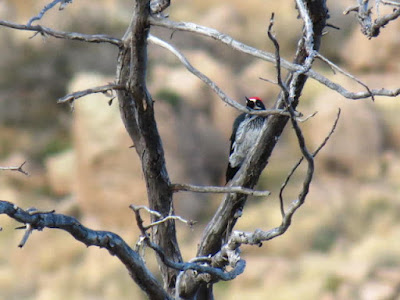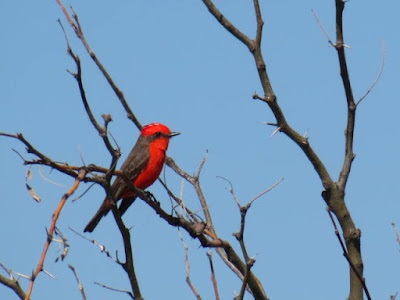 |
| Great blue heron, Florida, 2009 |
The Encyclopedia of North American Birds, by Michael Vanner, is far too large to serve as a guide in the field (or woods or mountains), but the big book is unsurpassed for indoor browsing and remembering. The wood stork and roseate spoonbill take me back to Aripeka, Florida, and the house on the island where the Artist and I spent several winter months with our beloved Sarah. A red-bellied woodpecker sometimes visited behind the house, and on the way out into the Gulf of Mexico from Weeki Wachee (other Florida years), on the road to little Pine Island, we saw sandhill cranes on their nest and raising young. The beautiful photographs in Vanner’s book bring the birds very much to life and give fresh color to my memories.
Arizona winters felt even birdier, either because we were older or because we spent more time sitting outdoors behind the cabin (especially in the spring of 2020), watching birds.
 |
| Meep, meep! |
The cactus wren was our morning rooster, the roadrunner always amusing entertainment. In the nearby Chiricahua National Monument we saw the striking acorn woodpecker, and sandhill cranes by the thousand drew us frequently farther south in Cochise County to Whitewater Draw (where I was thrilled to spot a white-faced ibis, also, one day), although we could see hundreds of the cranes just outside Willcox any day of the week. And in fact it was there, by what the Artist and I called “the ponds,” officially Twin Lakes, outside Willcox that I saw my first vermilion flycatcher, recognizing it from the pages of my field guides.
 |
| Acorn woodpecker: He is really there. |
 |
| Vermilion flycatcher |
 |
| Sandhill cranes |
In the spring of 2020, we stayed in Arizona late enough to see Gambel’s quail chicks. The whole family would come for a morning drink of water, filing along the old railroad ties that served to keep the backyard from washing downhill. They came in single file, and in single file they disappeared again down the hill after their visit. They made me think of a middle-class French family dressed up and out for a Sunday stroll.
Down at a neighbor’s house one morning, hoping to see a phainopepla (it never made an appearance that morning), I unexpectedly sighted a painted bunting (like the vermilion flycatcher, a bird recognized only thanks to repeated perusals of field guides) and also had an opportunity to watch orioles (I forget which kind) feeding their young under the porch eaves. Another neighbor had more hummingbird feeders, and thus more hummingbirds, than I’ve ever seen in a single place before. I had a single hummingbird feeder and the occasional black-chinned hummer.
The dearest Arizona bird memory, though, brought back to me by Vanner’s book, is of the little canyon towhee. A canyon towhee would hop around the cabin backyard and under our car, not at all disturbed by our presence. One of my Western bird field guide authors called it the “most confiding” of the towhees (perhaps he meant confident?), and somehow the Artist took that to be its name. “Is that the confiding towhee?” he would ask me. There was something homey and comforting about that bird’s presence in our outdoor, near-home life that spring, such a troubled season in the world at large. I have searched photo files for a picture of it, unsuccessfully, so here is Vanner's:
 |
| Canyon towhee in Vanner's book |
As you see, he is in many ways just another little brown bird (LBB), but I tell you, he has personality! The feathers on the top of his head are usually semi-erect and give him a perky look. Perky, yes. That word fits the confiding towhee we knew so well.
Two Michigan summers in a row, a pair of bluebirds nested in a dead popple tree near enough to our outdoor dining table that the Artist and I could watch the parents feeding their young while we enjoyed our alfresco suppers. That particular popple is history, but I bought a bluebird house at a yard sale on Saturday and hope it’s not too late to attract bluebirds again to my yard. Just have to figure out how to get the box up….
 |
| Hooded oriole in Dos Cabezes, Arizona |
4 comments:
Great bird pictures and stories, Pamela. Birds sure bring a lot of pleasure to my life, even my common backyard species.
It seems sometimes the less flashy the appearance, the more beautiful the singing -- song sparrows, house wrens, thrushes and thrashers, and the Quaker-grey mockingbird. Their songs put smiles in my mornings.
Birds are such a connection for so many of us. And what a cool book you have to wander through and remember. I hope you get your bluebird box up and that you have blue visitors soon! I love sitting on my deck in the late afternoons or evenings, watching the birds come in for their supper. Penny loves to sit out in the yard too, watching the birds fly overhead. Last night a single turkey came to visit. She thought that was a bit much and barked at it.
Sunny will chase birds when she sees them on the ground, but without wings she has little hope of catching any!
Post a Comment